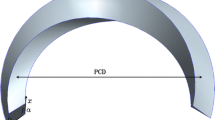Abstract
Viscous liquids can be encountered in many applications of micro devices. In this paper, an experimental and numerical simulation of a micro screw concentric tube heat exchanger is presented to determine the overall heat transfer coefficient and the amount of heat created by friction. The screw surface area and the increase in the viscosity of the liquid can raise the amount of heat created by friction and subsequently increase the amount of heat transferred in the micro concentric tube heat exchanger. Increasing the viscosity of the source can increase the overall heat transfer coefficient. The micro heat exchanger consists of a tube inside the screw placed inside a micro-channel. When the screw rotates, a net force is transferred to the fluid due to differential pressure on the depth of the thread and pressure gradient along the screw axis, thus causing the fluid to displace outside and inside the screw. A micro-screw heat exchanger was designed to maximize heat transfer from a liquid (viscous) in the cylinder to water in a tube inside a screw. Three-dimensional simulation of micro-screw heat exchanger was performed. The results obtained from CFD simulation have been compared with the experiments.












Similar content being viewed by others
Abbreviations
- Q :
-
rate of heat transfer, (W)
- \( {\mathop m\limits^ \cdot } \) :
-
mass flowrate of viscous liquid
- T exit :
-
exit temperature of viscous liquid from the micro-heat exchanger
- T inlet :
-
temperature of viscous liquid entering the micro-heat exchanger
- C p :
-
constant pressure specific heat of viscous liquid
- v·n:
-
the velocity component normal to the boundary ∑
- θ :
-
the temperature of viscous liquid
- X :
-
the vector of nodal unknowns such as velocity
- th:
-
thread (m)
- C h :
-
length of one turn of the helix curvature (m)
- d :
-
screw diameter (m)
- l :
-
screw length (m)
- A 0 :
-
the area of the cylinder
- A i :
-
the area of the tube in the screw
- r i :
-
the radius of the tube inside the screw
- r 0 :
-
the radius of the cylinder
- h i :
-
the heat transfer coefficient of the water
- h 0 :
-
the heat transfer coefficient of the viscous liquid
- K :
-
the thermal conductivity
- μ:
-
viscosity (Pa s)
- ρ:
-
liquid density (kg/m3)
- ω :
-
angular velocity (rpm)
References
Aparecido JB, Cotta RM (1990) Thermally developing laminar flow inside rectangular ducts. Int J Heat Mass Transf 33(2):341–347
Bau HH (1998) Optimization of conduits shape in micro heat exchangers. Int J Heat Mass Transf 41:2717–2723
El-Sadi H, Esmail N (2005a) Efficient design of microscrew pump by numerical simulation. Can J Chem Eng 83:944–950
El-Sadi H, Esmail N (2005b) Simulation of complex liquid in micropump. Microelectron J 36(7):657–666
El-Sadi H, Esmail N (2006) Simulation of three-dimensional transient performances in micro-pump. J Sens Actuators B Chem 115:510–518
Friedrich CR, Kang SW (1994) Micro-heat exchangers fabricated by diamond machining. Precis Eng 16:56–59
Gravesen P, Branebjerg J, Jensen O (1993) Microfluidics—a review. J Micromech Microeng 3:168–182
Hapke I, Boye H, Schmidt J, Staate Y (2000) Evaporation in micro-heat exchangers. Chem Eng Technol 23:496–500
Harris C, Despa M, Kelly K (2000) Design and fabrication of a cross flow micro heat exchanger. J Microelectron Mechan Syst 9:502–508
Kang SW, Chang GS (1996) The manufacture and test of (110) orientation silicon based micro heat exchanger. In: Proceedings of the 13th National conference of the Chinese society of mechanical engineers, November 127–133
Nagler O, Trost M, Hillerich B, Kozlowski F (1998) Efficient design and optimization of MEMS by integrating commercial simulation tools. J Sens Actuators A 66:15–20
Wei X, Joshi Y (2002) Optimization of stacked micro-channel heat sinks for micro-electronic cooling. Int Soc Conf Therm Phenom 441–448
Author information
Authors and Affiliations
Corresponding author
Rights and permissions
About this article
Cite this article
El-Sadi, H., Esmail, N. & Athienitis, A.K. High viscous liquids as a source in micro-screw heat exchanger: fabrication, simulation and experiments. Microsyst Technol 13, 1581–1587 (2007). https://doi.org/10.1007/s00542-006-0366-x
Received:
Accepted:
Published:
Issue Date:
DOI: https://doi.org/10.1007/s00542-006-0366-x




